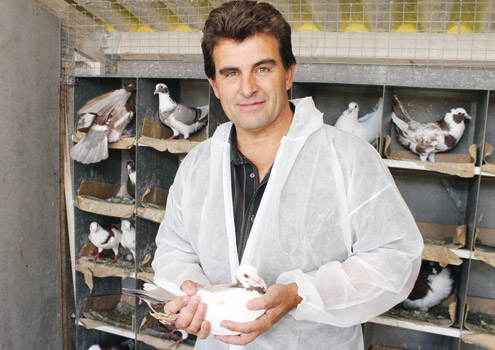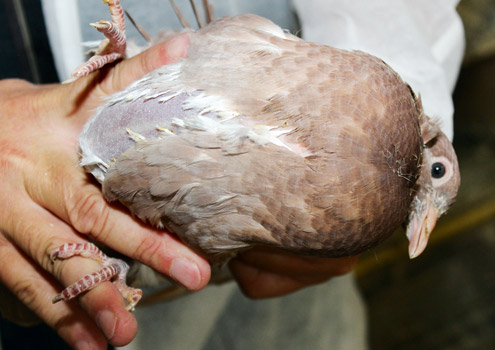Pigeons come home to roost in France

Pigeon farming in France is characterised by a mix of the traditional and the modern, as Philip Clarke discovers
Eat a pigeon in a British pub and the chances are it has been sourced locally and you’ll end up with a piece of shot on your plate.
Eat a pigeon in a French restaurant and it is more likely to have been produced in one of the country’s 400 pigeon farms, located in the north-west of the country.
Pigeon farming in France is a very traditional, pastoral activity. It is recorded that one of the first pieces of legislation following the French Revolution in the 1790s was to ban the keeping of pigeons, which was seen as a preserve of the elite.
More recently, pigeon production has re-emerged, initially as a “bolt-on” activity to general farming, but increasingly as a specialist enterprise for commercial operators. About half the farms supplied by breeding company Grimaud Frères have no other activity.
“Producing pigeons for meat is closer to rabbit farming than any other form of poultry production,” says Jean-Luc Boyer, who runs Grimaud Frère’s breeding operation.
The company has a high-biosecurity selection centre near Roussay in the Maine-et-Loire department, with 5,000 pairs of grandparent stock (GP) and 600 pairs of great grandparent stock (GGP).
Selected GP birds are then transferred to one of five multiplication units, to produce parent birds for sale to commercial farms.
The production cycle
The pigeon production systems on both breeding and commercial farms are almost identical, Mr Boyer explains.
The birds are kept in cages – typically 20 or 30 couples in each group. Each couple has two nest boxes and the first fertile eggs are laid when the birds reach sexual maturity at about seven months.
It takes 18 days of natural incubation for the eggs to hatch, with each couple typically producing two chicks.
For the first five days the chicks are fed on a milky secretion, produced in both parent birds’ crops, which is high in protein and energy-rich lipids. From five to 14 days this liquid is then mixed with pre-digested cereals, and fed to the chicks. From 14 to 28 days the pre-digested cereal is mixed with water.
At 28 days the chicks, or “squabs”, reach their “independence day” as Mr Boyer puts it, by which time they are fully feathered and able to feed themselves.
If they are on a breeding farm, this is when they will be transferred to a commercial farm as parent stock (PS). If they are on a commercial farm, they are transferred to the slaughterhouse for processing.
“At this stage they will weigh between 600g and 650g liveweight, enough to produce a 450g carcass,” says Mr Boyer. “The meat is very different to wild pigeon as the squabs have been fed on milk and cereals. It is a much milder meat, which customers prefer.”
And why two nest boxes? That is because after 10 days of the first two eggs hatching, the female lays two more and a second production cycle begins in tandem.
In this way, each couple produces about 20 eggs a year, from which they may raise 14 or 15 squabs.
Pigeon management

As with any form of poultry production, bird management and environmental control are critical to good productivity.
GP and PS pigeons are vaccinated at 28 days with a double injection into the breast – one for salmonella and one for paramixovirosis (Newcastle disease). They then receive a salmonella boost every eight months and a paramixovirosis jab once a year.
Feed is provided ad lib in troughs, made up of 75% maize and 25% high protein pellets, while water is delivered via low-level nipple drinkers.
“We were initially told that pigeons would not be able to use nipple drinkers as they have to immerse their whole beaks to drink,” Mr Boyer recalls. “But back in 1991 we trialled nipple drinkers and now everyone uses them.”
The nest boxes are traditionally made of wood with cardboard trays to collect the droppings, but the newer ones tend to be metal for ease of cleaning. The muck is cleared out after every two or three cycles and the cages sprayed with insecticide.
The birds are provided with about 16 hours of light a day (15 hours for GP stock), which means switching on the lights at 2am in the winter. The lighting system is very basic – just one bulb for each cage.
Traditional units are open faced, but increasingly production is being moved indoors, to improve biosecurity and reduce mortality. These newer units sometimes have dynamic ventilation and temperature control.
“Facilities are important, but the real key to good management is observation, knowing which females are not laying or which males are aggressive – and then dealing with it.”
THE PIGEON BREEDING PROGRAMME
Pigeon breeding at Grimaud Frères is headed by Magali Blanchet.
“The three most important traits we are selecting for are productivity, bodyweight and meat yield,” she says.
Each egg produced at the selection centre is registered and all three criteria are recorded every three months to produce an overall index and identify the best lines. GP birds are typically kept in trials for two years.
Productivity is measured in terms of squabs produced, per couple per year. “But productivity is more of a management issue than a breeding issue,” says Ms Blanchet. “We are able to get 18-20 squabs a year, but many of our customers are getting just 13 or 14 with the same genetic stock. The potential is already there.”
The focus is therefore more on bodyweight and, in particular, meat yield – by which she means conformation. “The aim is to produce a bird with a nice plump, well-rounded breast, as this is what the customers want.”
Over the past 20 years, average meat production per couple of PS pigeons has increased from 8kg a couple a year to 10.5kg a couple a year.
Some emphasis is also given to feather colour, with Grimaud Frères producing three main breeds – the Mirthys White, the Mirthys Coloured and the Europigeon Titan.
ECONOMICS OF PIGEON PRODUCTION
The market for pigeonmeat in France comes to about 4.1m tonnes a year – the biggest consumer in the EU, ahead of Italy with about 1.5m tonnes.
Grimaud Frères supplies about 25% of this trade, but further market penetration is limited by the practice of “auto-replacement”, with pigeon producers often holding back squabs to provide the next generation of parent stock.
To discourage this, Grimaud Frères is increasingly selling GP stock at six weeks old, rather than at seven months (sexual maturity) to help customers reduce costs. These young GP birds typically cost €14 a couple, compared with €35 a couple for seven-month birds.
The average value of squabs sold to the slaughterhouse comes to about €3 for a 570g live bird, though the top producers are getting a premium of a larger bird.
“Most producers are achieving about 550-570g, but we really need to push for 650g as, at this weight, the restaurants can cut the bird in half and get two servings per bird,” says Mr Boyer.
CASE STUDY: MICHEL MAINDRON, LA VERRIE, VENDEE, PAYS E LA LOIRE
Michel Maindron has been breeding pigeons with his brother Bernard for over 30 years.
The pigeon business accounts for about 90% of the total farm income, with the balance made up from a small herd of Charolais beef cattle.
The farm is unusual in that it contains both a GP multiplication unit, with about 2,600 bird places across two buildings, and a commercial unit, with 4,500 couples across six sheds.
About 25% of the PS birds are retained for own use, with 75% sold to other producers, fully vaccinated and sexed, fetching about €11 a couple..
As one of the region’s top producers, Michel is able to produce squabs of up to 650g.
Most of the sheds have been built within the past two years, being enclosed, but with wide channels to maximise ventilation. Each cage houses 20 couples, with wooden nest boxes.
Michel says that pigeon production brings in enough money for both him and his brother to lead a comfortable life, though both their wives have separate jobs off farm.
